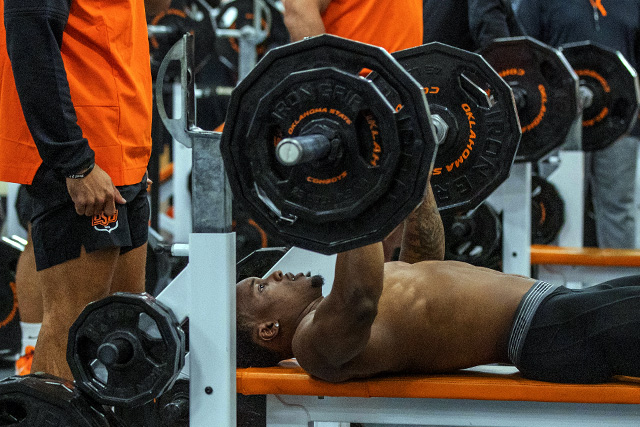In a set weight maximum bench press test, the subject performs as many bench presses as they can at a particular weight. Tests such as this one are part of the NBA pre-draft camp fitness test and the NFL combine testing. See also the max bench press test at a set cadence, and many other bench press tests.
 Max bench press fitness test at an American football combine
Max bench press fitness test at an American football combinetest purpose: to measure maximum strength endurance of the chest muscle groups.
equipment required: Bench with safety, standard Olympic bar, and various free weights up to 225 lbs.
pre-test: Explain the test procedures to the subject. Perform screening of health risks and obtain informed consent. Prepare forms and record basic information such as age, height, body weight, gender and test conditions. Check equipment for safety and calibrate weights if required. Perform a standard warm-up. See more details of pre-test procedures.
weight: In the pre-season draft testing combines, the NBA uses 185 lbs, NHL 150 lbs, and the NFL 225 lbs. In the SPARQ rating system for football, the weight used is 185 lbs.
procedure: An appropriate warm up procedure should be followed. For the NBA combine protocol, the warm up involves 10 push-ups, then after 60 seconds rest, 5 reps at 135 pounds, then after another 90 seconds attempt 185lbs as many times as possible. The bar is set to the appropriate weight, depending on the group to be tested. The athlete begins by lying in a supine position on the bench, with their feet flat on the floor and the upper and lower back in contact with the bench at all times. The bar is grasped at approximately 6 inches wider than shoulder width apart, so that the elbows are at right angles at the lowest point. A complete successful lift is counted from the starting position of the arms fully extended with the weight directly above the chest, to the weight just touching the chest, then returned to the starting position. The movement of the bar should be at a controlled speed and with a smooth motion, and the weight should remain in line with your nipples. In the SPARQ rating system, for safety reasons, no bouncing off the chest is allowed. The testing ends as soon as the athlete is unable to complete a repetition. See Bench Press Video.
scoring: the maximum number of full repetitions successfully completed is recorded.
advantages: the required equipment is readily available in most gymnasiums, and the test is simple to perform.
disadvantages: This test should only be performed by those experienced at performing the bench press lift with good technique. Good technique will also enable the lifter to maximize their score. If the weight is too light or too heavy, the results may not be a good indication of the participant's upper body strength, as the number of repetitions changes the involvement of the muscle energy systems.
comments: For safety, a spotter should stand at the head of the bench throughout the test. The test results of this test may be specific to the equipment used (height of bench, variations in weights), so is best to use the same equipment for test-retest measures. If any variation in technique was allowed, this should be recorded on the results sheet for referral when the test is repeated.
variations / modifications: the weight for this test can be varied depending on the fitness level and experience of the participants to be tested. A fairer test may be to use a set percentage of the participant's body weight, as in the relative bench press test. Another variation is to use a set cadence, such as in the bench press beep test.
The Test in Action
- Tests such as this one are part of the NBA pre-draft camp fitness test and the NFL combine testing.
- This test was once part of the Football (Gridiron) SPARQ Rating
Similar Tests
- Brockport Bench Press — the subject performs as many bench presses as possible using a 35lb (15.9kg) barbell.
- Relative bench press test — maximum number of bench presses using a % of body weight.
- Cadence Bench Press Test — the athlete lifts 70-80% of his body weight (pre-determined) utilizing free weights in time with the metronome (protocol as once used for the NHL combine).
- Another max bench press test at a set cadence.
Related Pages
- More about Bench Press Fitness Testing
- See video examples of bench press testing in action
- Bench press technique
- NBA pre-draft camp fitness tests, NHL combine testing and the NFL combine testing


 Current Events
Current Events